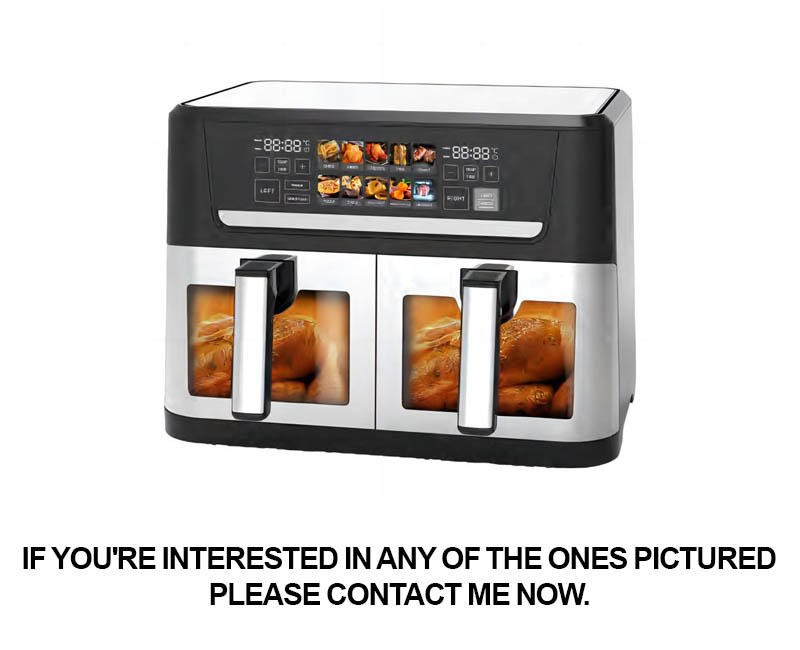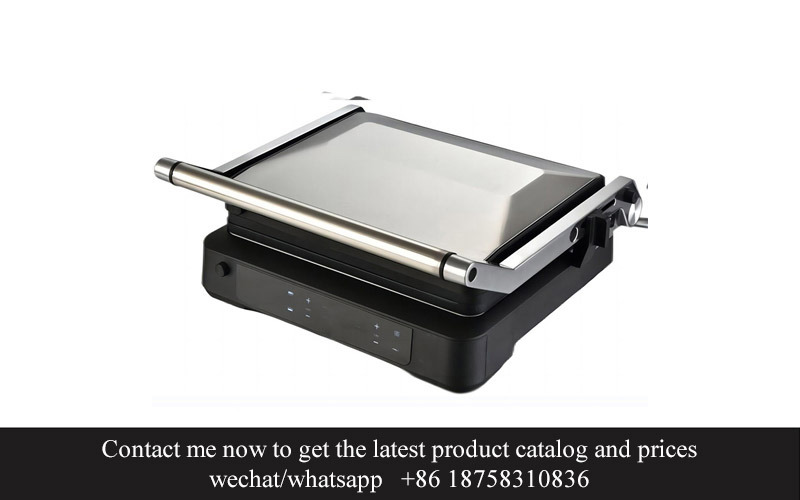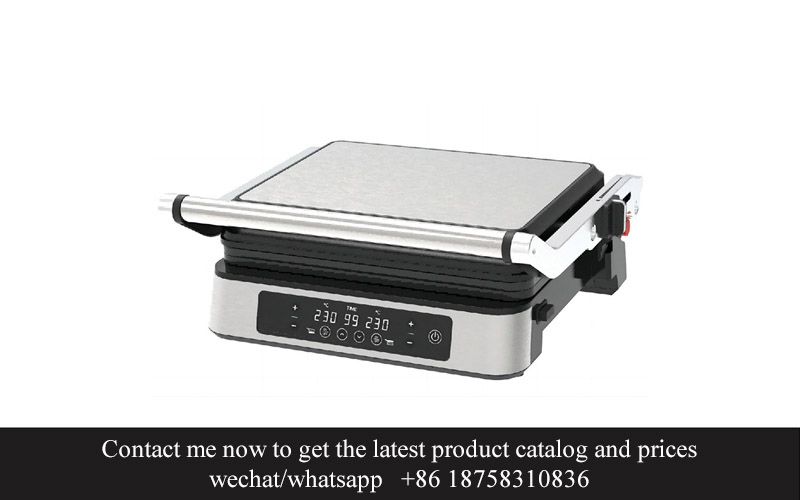Address
304 North Cardinal
St. Dorchester Center, MA 02124
Work Hours
Monday to Friday: 7AM - 7PM
Weekend: 10AM - 5PM
Address
304 North Cardinal
St. Dorchester Center, MA 02124
Work Hours
Monday to Friday: 7AM - 7PM
Weekend: 10AM - 5PM

As home kitchens continue to evolve, the rise of restaurant-grade air fryers has sparked a revolution in the way we cook at home. These advanced appliances are not just the convenience of commercial kitchens but are also redefining what’s possible in terms of flavor and health. Let’s explore the allure of these high-end air fryers and why they’re becoming the new must-have in modern kitchens.
The air fryer has long been a staple in home kitchens, offering a healthier alternative to deep-frying. But now, the game is changing with the rise of restaurant-grade air fryers, a game-changer for home cooks looking to elevate their culinary skills and cooking experience. These high-performance appliances are not just for commercial kitchens anymore; they’re making their way into the hearts and homes of food enthusiasts everywhere.
Gone are the days when air fryers were seen as a mere convenience gadget. Today, they are a symbol of culinary innovation, providing a way to achieve restaurant-quality results in the comfort of one’s own kitchen. The surge in popularity can be attributed to several factors, including a growing health consciousness among consumers, a desire for convenience, and the sheer appeal of gourmet-style cooking at home.
Health-conscious consumers are increasingly seeking out healthier cooking methods that reduce the fat and calories in their favorite dishes. Restaurant-grade air fryers offer a perfect solution, as they use hot air to circulate around the food, resulting in crispy, golden-brown outcomes with up to 80% less fat than traditional frying methods. This makes them an ideal choice for those looking to indulge in their favorite fried foods without the guilt.
The convenience factor cannot be overlooked. These air fryers are designed to be user-friendly, with intuitive controls and settings that make it easy to achieve perfect results every time. From crispy French fries to succulent chicken wings, the possibilities are endless, and the cleanup is a breeze compared to traditional frying methods.
But it’s not just about health and convenience; the allure of gourmet-style cooking at home is a major draw for many. With restaurant-grade air fryers, home cooks can now experiment with a wide range of recipes that were once only available in fine dining establishments. The ability to replicate the textures and flavors of restaurant dishes has sparked a wave of culinary creativity among home chefs.
The technology behind these air fryers has also evolved significantly. Modern models are equipped with advanced heating elements and precise temperature control, ensuring that the food is cooked to perfection. Features like adjustable temperature settings and programmable timers allow for greater control over the cooking process, making it easier to achieve the desired level of crispiness and doneness.
Moreover, the design of these appliances has become sleeker and more modern, fitting seamlessly into any kitchen aesthetic. From compact countertop models to larger, countertop or even built-in units, there’s an air fryer out there to suit every kitchen space and cooking need.
As the market for air fryers continues to grow, manufacturers are responding with a plethora of new features and innovations. Some models now come with additional functions such as dehydrating, roasting, and even baking, turning a single appliance into a multi-functional kitchen tool.
The rise of restaurant-grade air fryers has also sparked a community of home cooks who share recipes, tips, and tricks online. Social media platforms are brimming with air fryer enthusiasts who are eager to showcase their creations and inspire others to try their hand at restaurant-quality cooking.
In conclusion, the rise of restaurant-grade air fryers is a testament to the ever-evolving landscape of kitchen appliances. They have redefined what it means to cook at home, offering a blend of health, convenience, and culinary satisfaction that is hard to resist. Whether you’re a seasoned chef or a beginner in the kitchen, these air fryers are a game-changer that is likely to stay at the forefront of kitchen technology for years to come.

The European and American kitchen appliance industries have seen a remarkable transformation over the years, driven by evolving consumer preferences, technological advancements, and shifting market dynamics. Understanding these dynamics is crucial for anyone looking to navigate the competitive landscape of kitchen appliances.
In Europe, the market has been traditionally segmented, with countries like Germany, Italy, and the UK leading the way in terms of innovation and adoption rates. German consumers, in particular, are known for their preference for high-quality, durable appliances, which has influenced the industry to focus on premium products. Italian kitchens, on the other hand, are synonymous with culinary excellence, leading to a market that values both aesthetics and functionality.
The American market, while similar in its pursuit of quality, has a unique blend of regional tastes and preferences. The East Coast, for instance, is more inclined towards modern, sleek designs, while the South tends to favor appliances that offer a blend of traditional and contemporary styles. The West Coast, known for its health-conscious population, has seen a surge in demand for kitchen appliances that promote healthy cooking methods, such as air fryers and induction cooktops.
Both markets have witnessed a significant shift towards smart kitchen appliances. The integration of IoT (Internet of Things) technology has allowed for greater connectivity and control over kitchen appliances, making them more user-friendly and efficient. Smart ovens, refrigerators, and dishwashers are becoming increasingly popular, as they offer features like remote monitoring, automated recipes, and energy-saving modes.
Energy efficiency remains a key concern for both European and American consumers. As environmental consciousness grows, so does the demand for appliances that consume less energy and have a lower carbon footprint. This has led to the development of more energy-efficient models, which not only save money on utility bills but also contribute to a greener planet.
Another notable trend is the rise of multi-functional appliances. Consumers are looking for solutions that can perform multiple tasks, saving space and reducing the need for multiple devices. For example, combination ovens that can bake, roast, and steam have become popular, as have countertop appliances that can serve as both toasters and air fryers.
In Europe, the market is also influenced by cultural factors. For instance, the French kitchen appliance market is driven by a strong emphasis on culinary tradition and high-end products. Similarly, Scandinavian countries are known for their minimalist designs and eco-friendly appliances, which resonate with consumers who value sustainability.
In the American market, the influence of food trends cannot be overlooked. The rise of gourmet cooking, food blogs, and cooking shows has sparked an interest in professional-grade kitchen appliances among home cooks. This has led to a demand for appliances that can replicate restaurant-quality results in the comfort of one’s home kitchen.
Regulatory changes have also played a role in shaping the market dynamics. In both Europe and America, there are strict safety and energy standards that manufacturers must adhere to. These regulations have not only ensured consumer safety but have also pushed the industry to innovate and improve appliance designs.
Finally, the distribution channels for kitchen appliances have evolved. Online sales have become a significant part of the market, with more consumers turning to e-commerce platforms for convenience and a wider selection. Retailers are also adapting by offering more comprehensive services, such as installation and after-sales support, to differentiate themselves from online competitors.
In conclusion, the European and American kitchen appliance industries are complex and dynamic, with a multitude of factors influencing their growth and development. By understanding these market dynamics, manufacturers and retailers can better position themselves to meet the evolving needs of consumers and capitalize on emerging trends.

In the world of kitchen appliances, the air fryer has emerged as a versatile and healthy cooking option. But not all air fryers are created equal, especially when it comes to the restaurant-grade models. These appliances are designed to stand out with their advanced technology and robust features that cater to both professional chefs and home enthusiasts alike.
One of the key differentiators of restaurant-grade air fryers is their ability to maintain consistent temperatures. Unlike standard home models, these fryers often come with more precise heating elements and temperature controls. This ensures that food is cooked to perfection, with a crispy exterior and a juicy interior, just like you’d find in a professional kitchen.
The construction of restaurant-grade air fryers is also a cut above the rest. They are typically made with heavy-duty materials that can withstand the rigors of commercial use. Stainless steel interiors are common, providing a non-stick surface that’s easy to clean and resistant to rust and corrosion. The exteriors are often reinforced, making these fryers durable and long-lasting.
Another innovation lies in the size and capacity of restaurant-grade air fryers. While home models are often compact and designed for smaller batches, commercial fryers are built to handle larger quantities. This makes them ideal for families, caterers, and anyone looking to prepare substantial meals in one go. The larger capacity doesn’t compromise on efficiency, as these fryers are engineered to cook evenly across the entire basket.
One standout feature of many restaurant-grade air fryers is their adjustable cooking settings. Chefs and home cooks can tailor the cooking time and temperature to suit a wide range of foods. Whether you’re frying chicken, vegetables, or even breaded fish, these settings ensure that each dish achieves the perfect golden crust and tender texture.
Energy efficiency is a growing concern in kitchen appliances, and restaurant-grade air fryers are leading the charge. These models are designed to use less oil than traditional fryers, which not only reduces costs but also makes for healthier meals. The advanced heat circulation system ensures that food is cooked using a fraction of the oil, while still achieving that desirable crispiness.
Safety features are another area where restaurant-grade air fryers excel. With features like automatic shut-off, overheat protection, and cool-touch exteriors, these appliances are designed to prevent accidents and reduce the risk of burns. This is especially important in a commercial setting where multiple people may be handling the fryer.
Innovation isn’t just limited to the fryer itself; it extends to the accessories and attachments available. Many restaurant-grade air fryers come with additional cooking baskets, which can be used for different types of cooking or to separate batches of food. Some models even offer reversible baskets, which can be a game-changer for those looking to maximize their cooking space.
The technology doesn’t stop at the fryer. Many brands are integrating smart features, allowing users to control their appliances remotely via smartphone apps. This means you can start cooking your meal before you even arrive home, or monitor the progress while you’re out and about.
Finally, the noise level of restaurant-grade air fryers is often a significant improvement over their home counterparts. These fryers are designed to operate quietly, which is crucial in a commercial kitchen where noise can be a distraction.
In summary, the innovations in restaurant-grade air fryer technology are what set them apart from standard models. From precise temperature control and durable construction to energy efficiency and smart features, these appliances are a testament to the evolving landscape of kitchen technology. Whether you’re a professional chef or a home cook looking to elevate your culinary skills, a restaurant-grade air fryer is an investment that promises to deliver exceptional results.

Nestled in the heart of industrial progress, the restaurant-grade air fryer factory stands as a testament to modern culinary innovation. The walls, a canvas of machinery and precision, whisper tales of the meticulous craftsmanship that goes into crafting these kitchen marvels. As you step inside, the hum of activity is a symphony of efficiency and dedication.
Gleaming rows of machines, each with a specific role in the production process, stretch out before you. The first sight is of a high-tech cutting-edge system that meticulously slices and dices vegetables and meats to the precise dimensions required for optimal air frying. The precision of these machines is unparalleled, ensuring that every piece is uniform, which is crucial for even cooking and consistent results.
In the heart of the factory, the assembly line buzzes with life. Workers, clad in white overalls, move with practiced grace, attaching components with a precision that seems almost meditative. The air fryers are not just products; they are pieces of art, and each worker takes pride in their contribution to the final masterpiece. You can see the care in their hands as they fit together the intricate parts, each one a crucial element in the air fryer’s performance.
The focus on quality is evident at every turn. The factory employs rigorous quality control measures, with inspectors at every stage of the production process. These dedicated individuals examine the air fryers for any defects, ensuring that only the highest standards are met before they leave the factory. It’s a meticulous process, but one that guarantees the longevity and reliability of the product.
As you wander through the factory, you’re struck by the advanced technology that powers these air fryers. The design team has integrated cutting-edge features that set restaurant-grade models apart from their consumer counterparts. From the specially engineered fan systems that circulate hot air evenly to the durable, heat-resistant materials used in construction, every aspect is tailored for professional use.
The factory floor is a blend of old-world craftsmanship and futuristic technology. You’ll find skilled artisans hand-welding parts and applying the final touches to the air fryers, a blend that speaks to the factory’s commitment to excellence. These artisans understand the demands of the professional kitchen and their work reflects a deep understanding of the equipment’s intended use.
Safety is paramount in this environment. The factory is equipped with state-of-the-art safety features, including fire suppression systems and emergency protocols that are drilled into every employee. This focus on safety is not just a regulatory requirement; it’s a cultural value that is deeply ingrained in the factory’s ethos.
The journey through the restaurant-grade air fryer factory is not just a tour of a manufacturing facility; it’s a journey into the heart of culinary innovation. You see the passion and dedication that goes into creating these appliances, and it’s clear why they are the choice of professional chefs and discerning home cooks alike.
The factory’s commitment to sustainability is also noteworthy. They use energy-efficient processes and recycle materials wherever possible, reflecting a broader industry trend towards environmental responsibility. This approach not only reduces the factory’s carbon footprint but also sets a precedent for the products they produce.
As you exit the factory, you carry with you a sense of the magic that happens within these walls. The restaurant-grade air fryers are more than just appliances; they are the result of a collaborative effort between technology, craftsmanship, and a relentless pursuit of quality. It’s this fusion of elements that makes these air fryers not just functional, but a symbol of culinary excellence.

In the world of kitchen appliances, restaurant-grade air fryers have emerged as a beacon of innovation and convenience. But what sets them apart from their home counterparts? Here’s why opting for a restaurant-grade air fryer could be a game-changer for your kitchen.
The superior build quality of restaurant-grade air fryers is one of their most notable features. Crafted from heavy-duty materials, these fryers are designed to withstand the rigors of commercial use. Unlike the lightweight, plastic-bodied models found in most homes, restaurant-grade air fryers often feature stainless steel construction, ensuring they remain durable and reliable even after years of heavy use.
Efficiency is another key advantage. These fryers are engineered to cook food with precision, using less oil than traditional deep fryers. This not only reduces the fat content of your meals but also saves on energy costs. The advanced airflow system in restaurant-grade models circulates hot air around the food, providing an even cook that eliminates the need for constant stirring or flipping.
One of the standout features of restaurant-grade air fryers is their large capacity. While home models typically range from 2 to 5 quarts, restaurant-grade fryers can accommodate up to 10 quarts or more. This makes them perfect for feeding families or entertaining guests. Their spacious interiors allow for cooking larger batches of food at once, saving time and effort.
The controls on restaurant-grade air fryers are also a cut above the rest. With digital temperature and time controls, these fryers offer a level of precision that’s hard to match in home appliances. Users can set specific temperatures and cooking times, ensuring that their food is cooked to perfection every time. Some models even come with programmable settings and pre-programmed recipes, making it easier than ever to achieve professional-quality results.
Safety features are a top priority in restaurant-grade air fryers. These appliances are often equipped with safety locks to prevent accidental operation, as well as overheat protection to prevent damage to the unit and potential fires. Some models also feature auto-shutoff features, which turn off the fryer when it’s not in use or when the desired cooking time has elapsed.
The versatility of restaurant-grade air fryers is unparalleled. While they excel at frying, these appliances can also bake, roast, and grill. This means you can use them to prepare a wide variety of dishes, from crispy French fries to tender chicken wings, all without the mess and health concerns associated with traditional frying methods.
Another reason to choose a restaurant-grade air fryer is the peace of mind that comes with a reliable brand. Many of these fryers are manufactured by well-known brands with a reputation for quality and durability. This means you can expect excellent customer service and a longer lifespan for your appliance.
Lastly, investing in a restaurant-grade air fryer is a wise decision for those who value sustainability. These fryers use less oil and energy, which can lead to significant savings over time. Plus, they’re typically more durable, which means fewer appliances ending up in landfills.
In summary, restaurant-grade air fryers offer a superior cooking experience that’s both convenient and healthy. With their robust construction, precise controls, and versatile capabilities, these fryers are an excellent choice for anyone looking to elevate their home cooking game. Whether you’re a culinary enthusiast or simply someone who enjoys a good meal, a restaurant-grade air fryer could be the perfect addition to your kitchen.

In the ever-evolving world of kitchen appliances, data reveals a fascinating landscape of market trends and consumer insights. From the rise of smart kitchen gadgets to the growing demand for healthier cooking options, let’s delve into the numbers that paint a picture of the current state of the market.
Consumer Health Consciousness is on the RiseOne of the most significant trends in the kitchen appliance industry is the increasing health consciousness among consumers. According to a report by Grand View Research, the global air fryer market is expected to reach a value of $5.5 billion by 2025. This surge in popularity can be attributed to the health benefits of air frying, which uses hot air to circulate around food, reducing the need for oil and thus lowering fat content.
Technology Integration is KeyThe integration of technology into kitchen appliances has become a game-changer. Smart appliances that can be controlled via smartphones or voice assistants are becoming more prevalent. A study by Statista indicates that smart kitchen appliance sales are expected to grow at a CAGR of 14.3% from 2019 to 2023. This trend reflects a shift towards convenience and efficiency, as consumers seek appliances that can adapt to their busy lifestyles.
Sustainability and Eco-Friendly PracticesEnvironmental concerns are influencing purchasing decisions in the kitchen appliance market. A report by the European Environment Agency shows that consumers are increasingly looking for appliances that are energy-efficient and have a lower carbon footprint. This shift is driving the demand for appliances that not only perform well but also contribute to a greener planet.
E-commerce’s Impact on SalesThe rise of e-commerce has had a profound impact on the kitchen appliance industry. Online sales platforms have made it easier for consumers to access a wide range of products, and they are often more affordable. According to a survey by Statista, 42% of consumers in the U.S. and Canada have made kitchen appliance purchases online in the past year. This trend is likely to continue as more consumers turn to the internet for their shopping needs.
Urbanization and Compact LivingUrbanization and the trend towards compact living spaces are also shaping the kitchen appliance market. Smaller, more efficient appliances that can fit into smaller kitchens are in high demand. A report by Euromonitor International highlights that the demand for compact kitchen appliances has been growing, driven by the need for space-saving solutions in urban homes.
Demographic Shifts and Diverse PreferencesDemographic shifts, such as the aging population and the rise of single-parent households, are influencing consumer preferences. For example, there is a growing demand for appliances that are easy to use and maintain, as well as those that offer a variety of cooking functions to cater to diverse dietary needs. A study by the International Council on Aging found that 60% of older adults prefer kitchen appliances that are simple to operate.
Globalization and Cross-Cultural InfluencesGlobalization has led to a more interconnected kitchen appliance market, with cross-cultural influences shaping consumer preferences. For instance, the popularity of Asian cuisine has spurred a demand for appliances that can handle the specific cooking techniques required for dishes like sushi and dumplings. A report by Euromonitor International notes that the global kitchen appliance market is becoming more diverse, with products tailored to specific cultural tastes.
The Importance of Brand ReputationBrand reputation remains a crucial factor in the kitchen appliance market. Consumers are willing to pay a premium for trusted brands that offer quality and reliability. A survey by Nielsen found that 55% of consumers consider brand reputation when making a kitchen appliance purchase. This underscores the need for manufacturers to maintain strong brand identities and customer loyalty programs.
In conclusion, the kitchen appliance market is driven by a combination of health-conscious consumers, technological advancements, environmental concerns, and changing demographics. Understanding these market trends and consumer insights is essential for manufacturers and retailers looking to stay ahead in this dynamic industry.

In the ever-evolving landscape of kitchen appliances, the future holds a plethora of predictions and opportunities that promise to revolutionize how we cook and live. From smart technology integration to eco-friendly designs, the next generation of kitchen appliances is poised to make significant strides. Here’s a glimpse into the future:
Smart Integration and ConnectivityThe kitchen of the future will be a hub of smart technology, where appliances communicate seamlessly with each other and with users through mobile devices. Imagine a scenario where your refrigerator can order groceries based on your pantry inventory or your oven can adjust its settings remotely through an app. The rise of the Internet of Things (IoT) in kitchen appliances will not only enhance convenience but also efficiency.
Energy Efficiency and SustainabilityWith growing environmental concerns, energy efficiency will be a cornerstone in the development of new kitchen appliances. Manufacturers are expected to focus on reducing energy consumption without compromising performance. This includes advancements in insulation, improved motor technology, and the use of renewable energy sources. Appliances that can harness solar power or operate on recycled materials will become increasingly popular.
Personalization and CustomizationTailoring kitchen appliances to individual preferences and needs is a trend that’s gaining momentum. Smart appliances will not only adapt to cooking styles but also learn from user habits over time. For instance, a future oven might automatically adjust cooking times and temperatures based on the user’s past preferences or the specific characteristics of the dish being prepared. Customization could extend to modular designs that allow users to mix and match components to create a kitchen that fits their unique lifestyle.
Health and Wellness FeaturesAs health consciousness continues to rise, kitchen appliances will increasingly incorporate features that support a healthy lifestyle. This might include built-in nutrition tracking systems, air filtration for healthier cooking environments, or appliances designed to minimize waste. Features like non-toxic coatings and automatic cooking modes that reduce oil and fat content are just a few examples of how appliances might cater to wellness-oriented consumers.
Eco-Friendly and Disposal ConsiderationsThe lifecycle of kitchen appliances is set to become a significant factor in their design. Manufacturers will focus on creating appliances that are easier to recycle and disassemble at the end of their life. The emphasis will be on reducing electronic waste and ensuring that components are made from sustainable materials. Additionally, appliances might be designed to last longer, with replaceable parts and fewer single-use components.
Interactive and Educational AppliancesIn the future, kitchen appliances may serve as interactive learning tools, teaching users about nutrition, cooking techniques, and sustainable practices. For example, a smart countertop oven could provide cooking lessons and suggest healthy recipes, or a refrigerator could offer dietary advice based on the user’s health data. These appliances will not just be tools but also companions in the journey towards healthier living.
Aesthetics and Space OptimizationThe aesthetic appeal of kitchen appliances will continue to play a role in their design. Manufacturers are likely to focus on sleek, modern aesthetics that complement various kitchen styles. Moreover, the future of kitchen appliances will see a push for space-saving designs, particularly in urban settings where space is at a premium. Compact and multifunctional appliances will become more common, offering users a wide range of capabilities without taking up excessive space.
Global Trends and Cultural IntegrationAs the world becomes more interconnected, kitchen appliances will reflect a blend of global culinary trends and cultural influences. From fusion cookware that combines traditional methods with modern technology to appliances that cater to diverse dietary needs, the future kitchen will be a melting pot of culinary traditions. This global integration will not only enrich the cooking experience but also encourage culinary exploration and innovation.
In conclusion, the future of kitchen appliances is bright with opportunities for innovation that cater to the evolving needs and desires of consumers. From smart technology to sustainability, health and wellness, and aesthetic appeal, the next generation of kitchen appliances will undoubtedly enhance our lives in more ways than one.

In the realm of home cooking, the introduction of restaurant-grade air fryers has sparked a revolution. These kitchen gadgets are not just a trend; they’re a testament to the evolving landscape of culinary technology. They offer a blend of convenience, health benefits, and the ability to recreate restaurant-quality dishes at home. Let’s delve into why these air fryers are becoming the go-to choice for many kitchen enthusiasts.
The sleek design of restaurant-grade air fryers is not just about aesthetics; it’s a nod to functionality. These appliances are engineered to be space-saving, with compact dimensions that fit seamlessly into any kitchen layout. Their modern look also ensures they complement contemporary kitchen decor, making them a stylish addition to any countertop.
Performance-wise, restaurant-grade air fryers are a step above the standard models. They boast advanced heating elements that circulate hot air at high speeds, ensuring even cooking without the need for oil. This not only reduces the fat content in your meals but also cuts down on cleanup time. The technology behind these fryers is sophisticated, allowing for precise temperature control and adjustable cooking times, which is crucial for achieving the perfect texture and flavor.
Health-conscious consumers are flocking to restaurant-grade air fryers for their ability to offer healthier cooking options. Traditional frying methods often involve deep-fat cooking, which can be high in calories and unhealthy fats. Air frying, on the other hand, uses a fraction of the oil, making it a more heart-healthy choice. This feature is particularly appealing to those following low-carb, paleo, or keto diets, as it allows them to enjoy their favorite fried foods without the guilt.
The versatility of restaurant-grade air fryers is another compelling reason to choose them for your kitchen. These appliances can do more than just fry. Many models come with additional features that allow for roasting, baking, and even dehydrating. This means you can use a single appliance to prepare a wide range of dishes, from crispy French fries to juicy chicken wings and even homemade pizza.
In terms of user experience, restaurant-grade air fryers are designed with convenience in mind. Most models come with digital displays and programmable settings, making it easy to set the desired temperature and cooking time. Some even have features like automatic shut-off and preheat functions, ensuring that your food is cooked to perfection every time. The intuitive interfaces and user-friendly controls make these appliances accessible to cooks of all skill levels.
When it comes to the environment, restaurant-grade air fryers are a greener choice. With their energy-efficient design and the reduction in oil usage, these appliances contribute to a lower carbon footprint. This eco-friendly aspect is increasingly important to consumers who are looking for sustainable kitchen solutions.
The market for restaurant-grade air fryers is also witnessing a surge in innovation. Brands are continuously pushing the boundaries by introducing new features, such as smart technology integration. These fryers can now be controlled via smartphone apps, allowing users to monitor and adjust cooking settings remotely. This level of connectivity is not just convenient but also indicative of the direction in which kitchen appliances are heading.
For those who are still on the fence about making the switch to a restaurant-grade air fryer, consider the cost-effectiveness. While these appliances may come with a higher upfront cost compared to standard models, their durability and versatility often mean they pay for themselves over time. Plus, the savings on oil and the health benefits they offer can be substantial.
The social aspect of cooking is also a factor to consider. With the ability to create restaurant-quality dishes at home, you can impress guests with your culinary skills without the need for a professional kitchen. This can be a great conversation starter and a way to bond with family and friends over a shared meal.
In conclusion, the choice of a restaurant-grade air fryer for your kitchen is not just about cooking healthier and more diverse meals. It’s about embracing the future of kitchen appliances, which is characterized by innovation, convenience, and sustainability. These fryers are not just a tool; they’re a gateway to a new level of cooking experience that can elevate your home cooking to new heights.